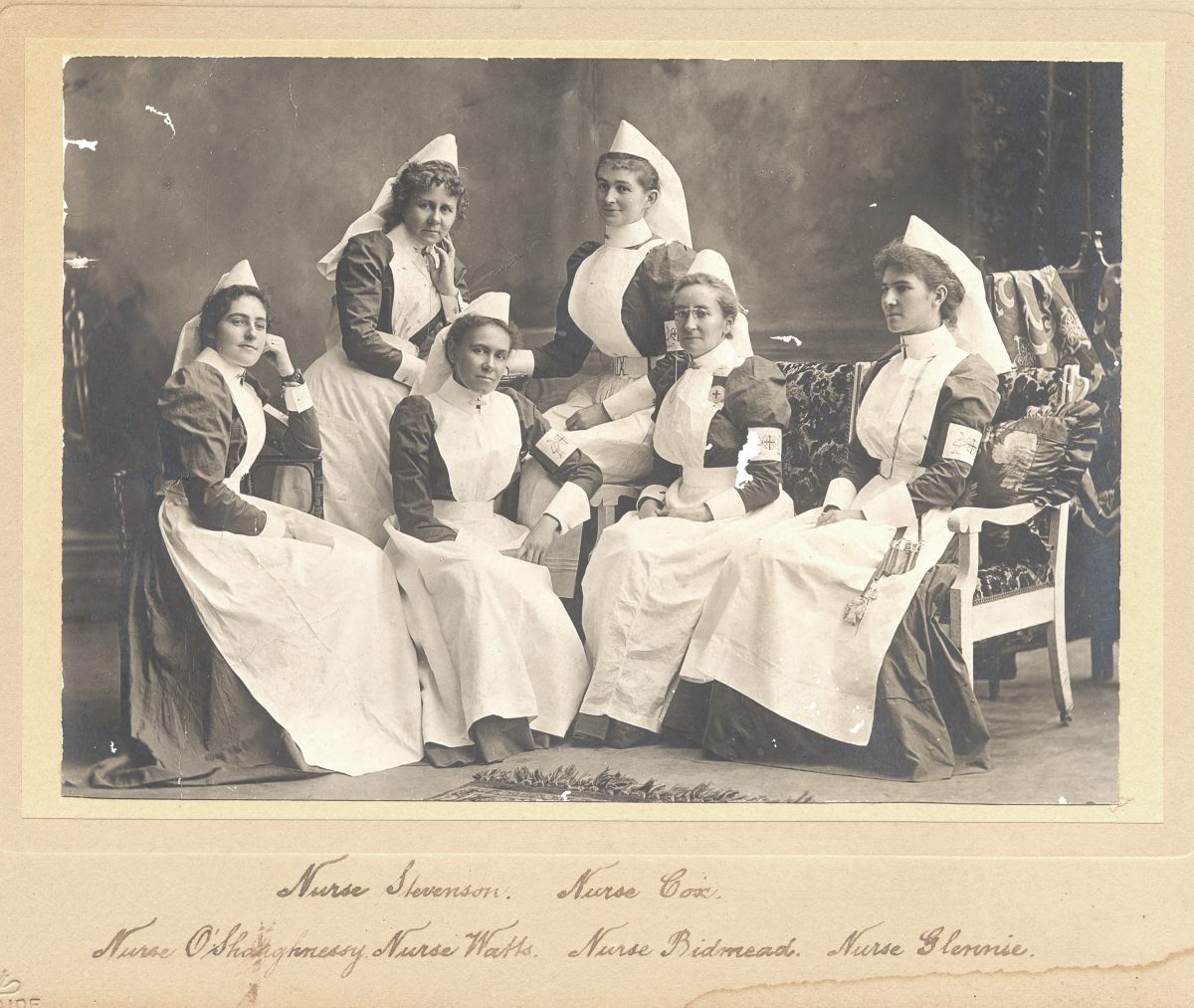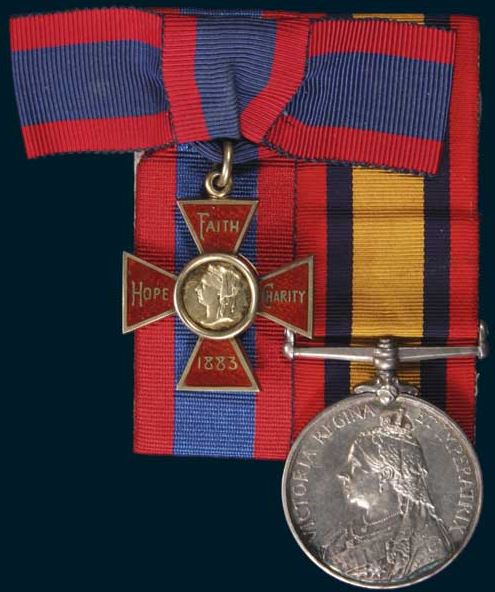Short in stature, with a bustling nature, Martha was a natural leader with a positive character and a deep rich voice.
Born in Guernsey, Martha and her four younger sisters emigrated to South Australia in 1884 after the death of their parents. A year later, at age 23, Martha and one of her sisters started training as nurses at the Adelaide Children’s Hospital. Upon graduation, Martha stayed at the Children’s Hospital working as a Charge Nurse. Her sister, meanwhile, went to work at the Adelaide Hospital and became Superintendent of Night Nurses before moving to the Western Australian goldfields.
When one of Martha’s contemporaries, Alice Tibbitts, purchased a private hospital on Wakefield Street, Martha went to work for her. Due to overcrowded and insufficient hospital accommodation in Adelaide, Miss Tibbitts also introduced home nursing, sending her nurses out to attend private cases in the home. Martha gained experience both in the hospital setting and in private nursing.
While at Miss Tibbitts’s Hospital, Martha worked with Dr JC Verco and Dr TK Hamilton. Dr Hamilton wrote:
I have never given a testimonial with greater pleasure than I now give this to Miss Bidmead. She has given me the utmost satisfaction in the way she had discharged her duties here. She is a most capable and well-trained nurse and, possesses to a marked degree all the requisite qualifications to make her successful in carrying out her duties in whatever capacity she be called to act.
The Express & Telegraph, 10 February 1900, page 4
Martha worked at Miss Tibbitts Hospital for ten years, then when the Burra Hospital opened its new Isolation Block in 1898 with the need for extra nurses, Martha moved and became a Charge Nurse at the Burra Hospital. When she was selected as one of the six nurses from South Australia to go to South Africa, the members of the Burra Hospital presented her with a small purse of sovereigns and considered her an:
ideal nurse and in every way suitable for the position to which she has been appointed. She carries with her the good wishes of the Burra people, and will always be welcome to a position on the local Hospital staff.”
Burra Record, 14 February 1900, page 2
In response to the war happening in South Africa in 1900, the South Australian Fund for War Nurses (part of the Patriotic Fund Movement) recruited and funded six nurses to go overseas. In total, nine South Australian nurses went to the Boer War. The army had nothing to do with this group which was regarded as civilian and they embarked as commercial passengers in Melbourne. Although, Government House ensured that the British military authorities in South Africa knew that they would be arriving and that they had official status.
Prior to leaving, the Fund insured the nurses for one hundred pounds each for one year ‘as it was quite possible that some of the party might be shot, and still more likely, that they might become victims to fever or other complaints” and continued to insure the nurse for the entire time they were overseas. The Fund also provided outfits for each nurse which included a blue serge gown and cloak lined with red, three blue linen gowns, six red twill aprons “for when they can’t be washed’, six white aprons, bonnet, shady hat and helmet. Each nurse was provided with a case of instruments ‘that rollup like a doctors’.

When Martha arrived in South Africa, the South Australian nurses were posted to Bloemfontein, which was a long uncomfortable three day train journey from No 2 General Hospital Wynberg. When they arrived, they found the accommodation, previously used by the Boers, in a terrible condition. There was no furniture, with cushions on the floor for seats and boxes as tables.
Blemfontein was a fair-sized town … the number of civilians we meet is extremely small, nothing but men in khaki wherever one goes, which is not surprising when one considers that about 148000 men are camped in and about the town … The shops are very funny. Most of them have two lists in the window, one saying what they have sold out of, the other what they have remaining in stock … firewood is almost unobtainable, and one woman we went to for laundry was burning chairs to keep her fire going.
SA Register, 6 June 1900
Heavy fighting around the town, meant Martha and the South Australian Nurses were thrust into a rush of work from the day after they arrived with no time off duty unless to grab some sleep. “A bed is no sooner emptied than it is reoccupied. We had not nearly enough beds for them”. The pace was frenetic and after five months, Martha was worn out. Nurses were only given a fortnights holiday which had to be spent at Cape Town. The journey each way took five days, only leaving them with four days of actual holiday for rest and recovery.
By June 1901, Martha was the only South Australian nurse remaining in Bloemfontein, as the other nurses had moved to Pretoria to assist with an enteritic outbreak.
I am now on duty at the Sisters Hospital. I was certainly not ill enough to come in as a patient myself, as the doctor wished me. Six weeks of peace and quietness, tonics, and drives with invalided sisters, has done its work. I am once more feeling extremely well and fit and putting on flesh rapidly
The Express and Telegraph, 5 June 1901
On return to duty in August 1901, Martha was promoted to Acting Superintendent of Nurses at No5 Stationary Hospital, Bloemfontein. As well as supervising all the nurses, she was also in charge of her own ward. She remained at Bloemfontein until the end of war when she went to London with a ship of wounded soldiers.
While in London, she received a telegram from the Under Secretary for State of War, stating that she will be invested by The King with the Royal Red Cross. The award is for those from the United Kingdom and Commonwealth countries for exceptional services in military nursing. Martha was the first South Australian woman to be awarded the Royal Red Cross for her work during the Boer War.
“I received a telegram from the Under Secretary of State for War, stating The King will invest you with the Royal Red Cross on Wednesday March 12 at noon at St James’s Palace. His majesty has decided that ladies who are to receive the Royal Red Cross are to curtsey once, then kneel down, have the decoration pinned on in the usual way, then kiss the King’s hand, and curtsey before they leave his presence … The King was seated in a state chair under a sort of canopy, and my first idea was how very good his portraits are. He was wearing what I suppose is a field-marshal’s uniform, with a broad sash across the shoulder. I thought he looked tired, as well he might, but he has a very kind and a very pleasant expression, which appears to be specially for the individual whom he is decorating … I walked forward on the square carpet on which the chair was place, dropped a curtsey, not a very low one, as I had my doubts as to being able to rise again safely, then advance to the velvet cushion placed at the Kings feet and knelt on one knee. I had decided previously to bend the right one, but in the hurry of the moment it seemed to my disturbed imagination that I possessed a number of knees from which to choose. The hesitation was only momentary, but very uncomfortable whilst it lasted. I finally decided on my right knee. The King took the cross from a cushion, handed him by an official standing at his left hand and hooked it on to my pendant. I raised my right hand, the King put his over it and I respectfully saluted it. Then I rose, dropped another curtsey, and retired backwards towards the door on the left-hand side of the room.”
(Letter from Nurse Bidmead to Lady Brown, 3 May 1904, Adelaide Observer)

Noble Numismatics Pty Ltd
On her return to Australia in 1902, she was presented with the Devoted Service Cross, given to those who were sent by the South Australian Fund for War Nurses. The Medal was described as being:
Gold and in the form of a Laurel Wreath overlayed by the crossed flags of the Union Jack and South Australia, the whole suspended by two chains from a plain bar with the inscription ‘1901 Africa’ 1902. On the reverse of the decoration was the inscription: Presented to Nursing Sister Bidmead, on behalf of the subscribers to the South Australia Fund for War Nurses.
The Australian Boer War Memorial: http://www.bwm.org.au/index.php
Martha returned to work in private nursing in and around Adelaide before becoming General Secretary and Superintendent of the District Trained Nursing Society of South Australia in November 1912. This organisation provided in-home nursing care for the poor and underprivileged. She remained in charge until she retired in 1926. During her retirement, Martha travelled back to the United Kingdom and in Adelaide spent enjoyable hours tending her garden at Guernsey Cottage, the house she and her sisters shared at Payneham.
She died aged 77 on 23 July 1940.
By Margot Way, CALHN Health Museum